radiator TOYOTA AVALON 2021 Owners Manual (in English)
[x] Cancel search | Manufacturer: TOYOTA, Model Year: 2021, Model line: AVALON, Model: TOYOTA AVALON 2021Pages: 548, PDF Size: 13.4 MB
Page 374 of 548
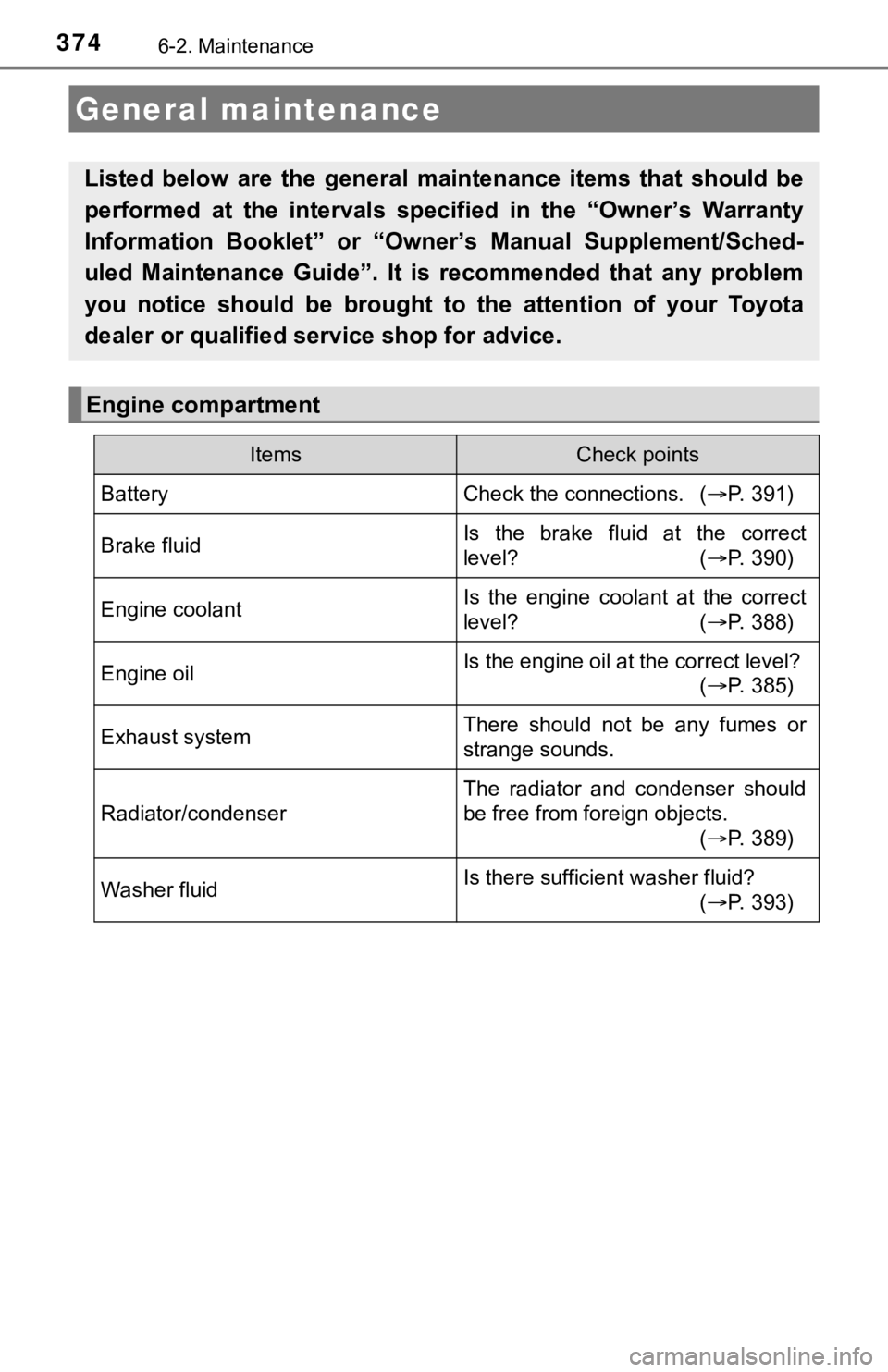
3746-2. Maintenance
General maintenance
Listed below are the general maintenance items that should be
performed at the intervals specified in the “Owner’s Warranty
Information Booklet” or “Owner’s Manual Supplement/Sched-
uled Maintenance Guide”. It is recommended that any problem
you notice should be brought to the attention of your Toyota
dealer or qualified service shop for advice.
Engine compartment
ItemsCheck points
BatteryCheck the connections. (P. 391)
Brake fluidIs the brake fluid at the correct
level? (P. 390)
Engine coolantIs the engine coolant at the correct
level? (P. 388)
Engine oilIs the engine oil at the correct level?
(P. 385)
Exhaust systemThere should not be any fumes or
strange sounds.
Radiator/condenser
The radiator and condenser should
be free from foreign objects.
(P. 389)
Washer fluidIs there sufficient washer fluid?
(P. 393)
Page 379 of 548
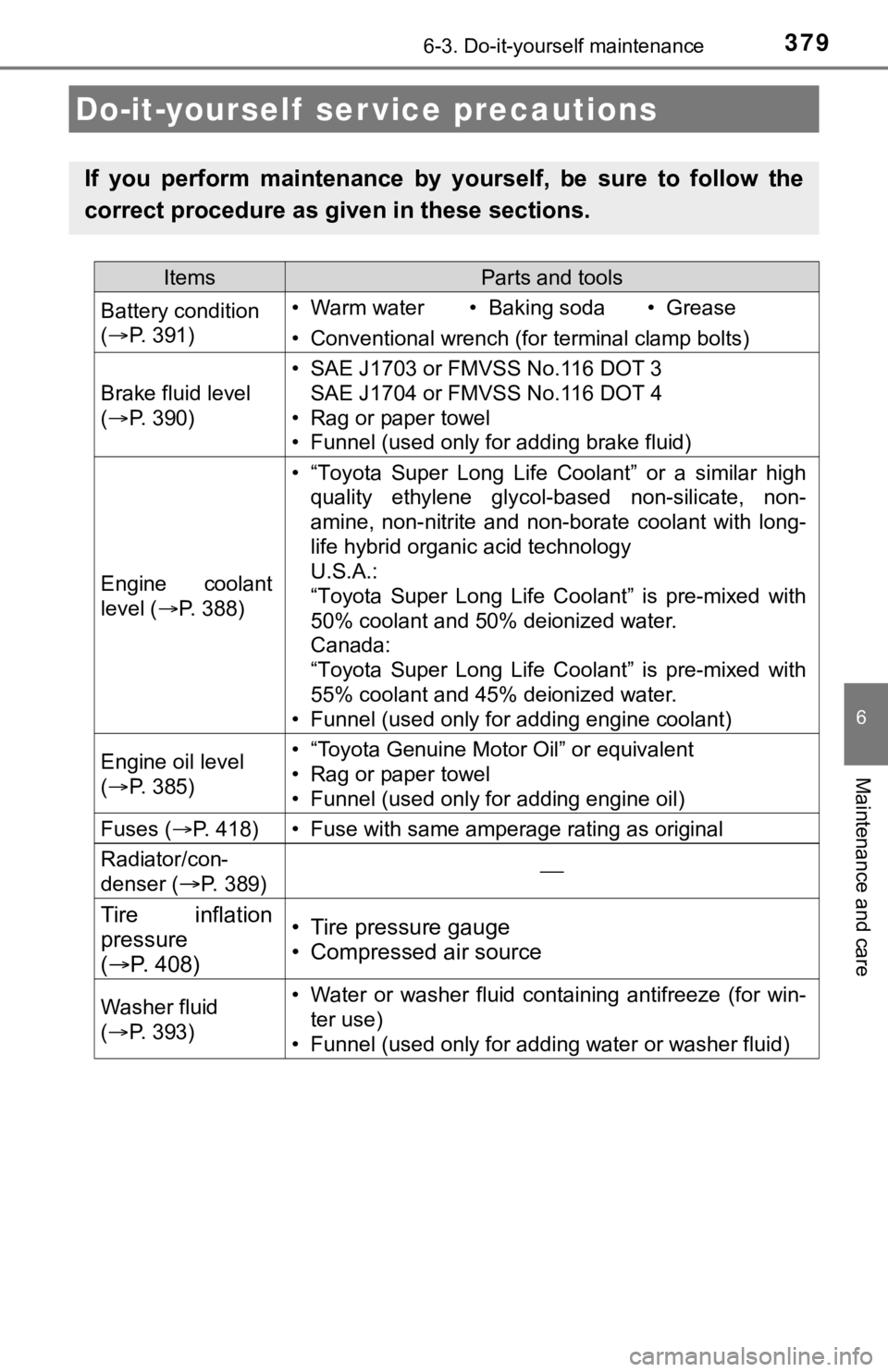
379
6
Maintenance and care
6-3. Do-it-yourself maintenance
Do-it-yourself ser vice precautions
If you perform maintenance by yourself, be sure to follow the
correct procedure as given in these sections.
ItemsParts and tools
Battery condition
(P. 391)• Warm water• Baking soda• Grease
• Conventional wrench (for terminal clamp bolts)
Brake fluid level
(P. 390)
• SAE J1703 or FMVSS No.116 DOT 3
SAE J1704 or FMVSS No.116 DOT 4
• Rag or paper towel
• Funnel (used only for adding brake fluid)
Engine coolant
level (P. 388)
• “Toyota Super Long Life Coolant” or a similar high
quality ethylene glycol-based non-silicate, non-
amine, non-nitrite and non-borate coolant with long-
life hybrid organic acid technology
U.S.A.:
“Toyota Super Long Life Coolant” is pre-mixed with
50% coolant and 50% deionized water.
Canada:
“Toyota Super Long Life Coolant” is pre-mixed with
55% coolant and 45% deionized water.
• Funnel (used only for adding engine coolant)
Engine oil level
(P. 385)• “Toyota Genuine Motor Oil” or equivalent
• Rag or paper towel
• Funnel (used only for adding engine oil)
Fuses (P. 418)• Fuse with same amperage rating as original
Radiator/con-
denser (
P. 389)
Tire inflation
pressure
(P. 408)• Tire pressure gauge
• Compressed air source
Washer fluid
(P. 393)• Water or washer fluid containing antifreeze (for win-
ter use)
• Funnel (used only for adding water or washer fluid)
Page 380 of 548
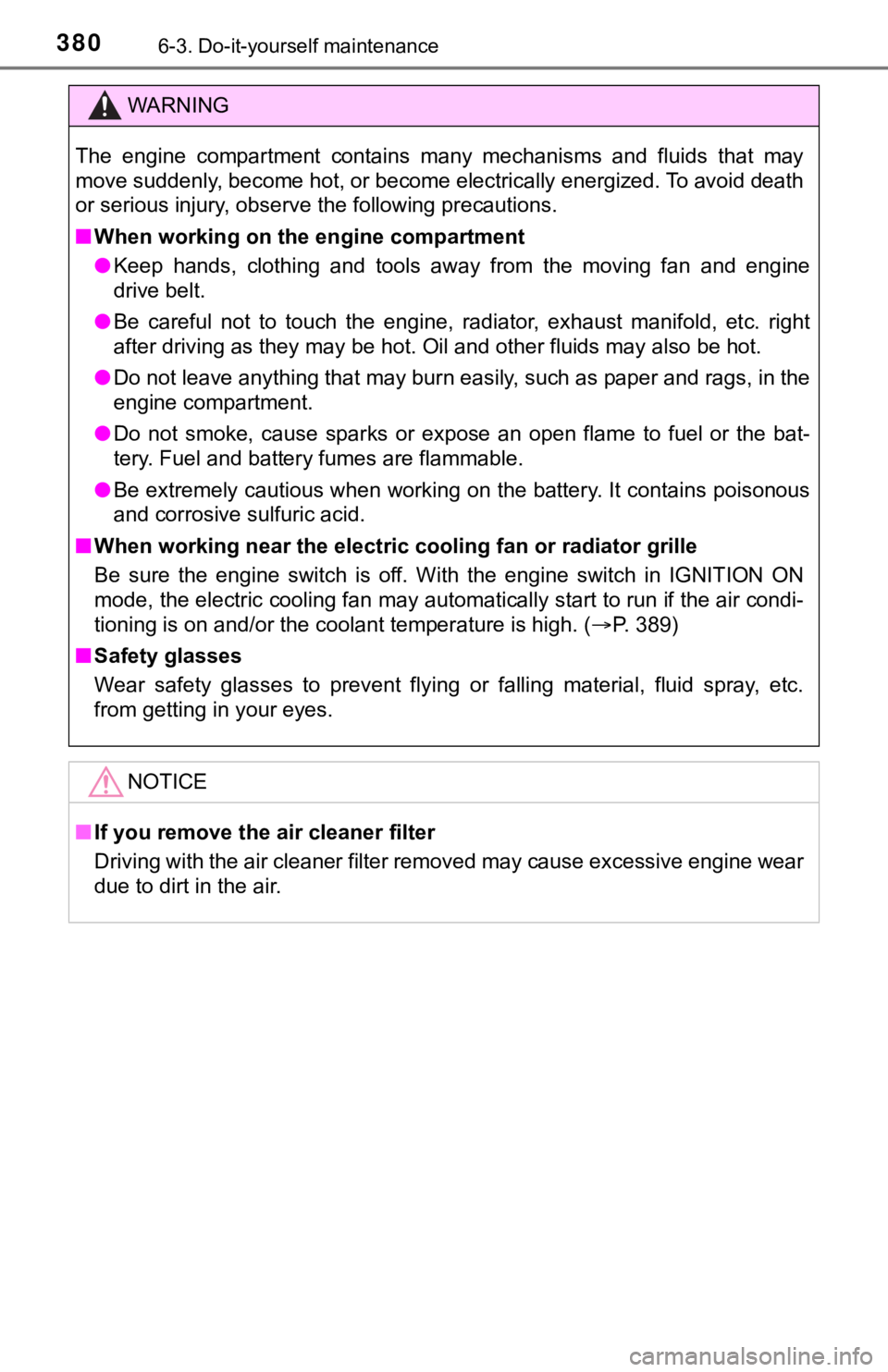
3806-3. Do-it-yourself maintenance
WARNING
The engine compartment contains many mechanisms and fluids that may
move suddenly, become hot, or become electrically energized. To avoid death
or serious injury, observe the following precautions.
■When working on the engine compartment
●Keep hands, clothing and tools away from the moving fan and engine
drive belt.
●Be careful not to touch the engine, radiator, exhaust manifold, etc. right
after driving as they may be hot. Oil and other fluids may also be hot.
●Do not leave anything that may burn easily, such as paper and rags, in the
engine compartment.
●Do not smoke, cause sparks or expose an open flame to fuel or the bat-
tery. Fuel and battery fumes are flammable.
●Be extremely cautious when working on the battery. It contains poisonous
and corrosive sulfuric acid.
■When working near the electric cooling fan or radiator grille
Be sure the engine switch is off. With the engine switch in IGNITION ON
mode, the electric cooling fan may automatically start to run if the air condi-
tioning is on and/or the coolant temperature is high. (P. 389)
■Safety glasses
Wear safety glasses to prevent flying or falling material, fluid spray, etc.
from getting in your eyes.
NOTICE
■If you remove the air cleaner filter
Driving with the air cleaner filter removed may cause excessive engine wear
due to dirt in the air.
Page 383 of 548

3836-3. Do-it-yourself maintenance
6
Maintenance and care
2.5 L 4-cylinder (A25A-FKS) engine
Engine compartment
Fuse boxes (if equipped)
(P. 418)
Engine oil filler cap (P. 386)
Engine oil level dipstick
(P. 385)
Brake fluid reservoir
(P. 390)
Battery (P. 391)Radiator (P. 389)
Electric cooling fan
Condenser (P. 389)
Engine coolant reservoir
(P. 388)
Washer fluid tank (P. 393)1
2
3
4
5
6
7
8
9
10
Page 384 of 548
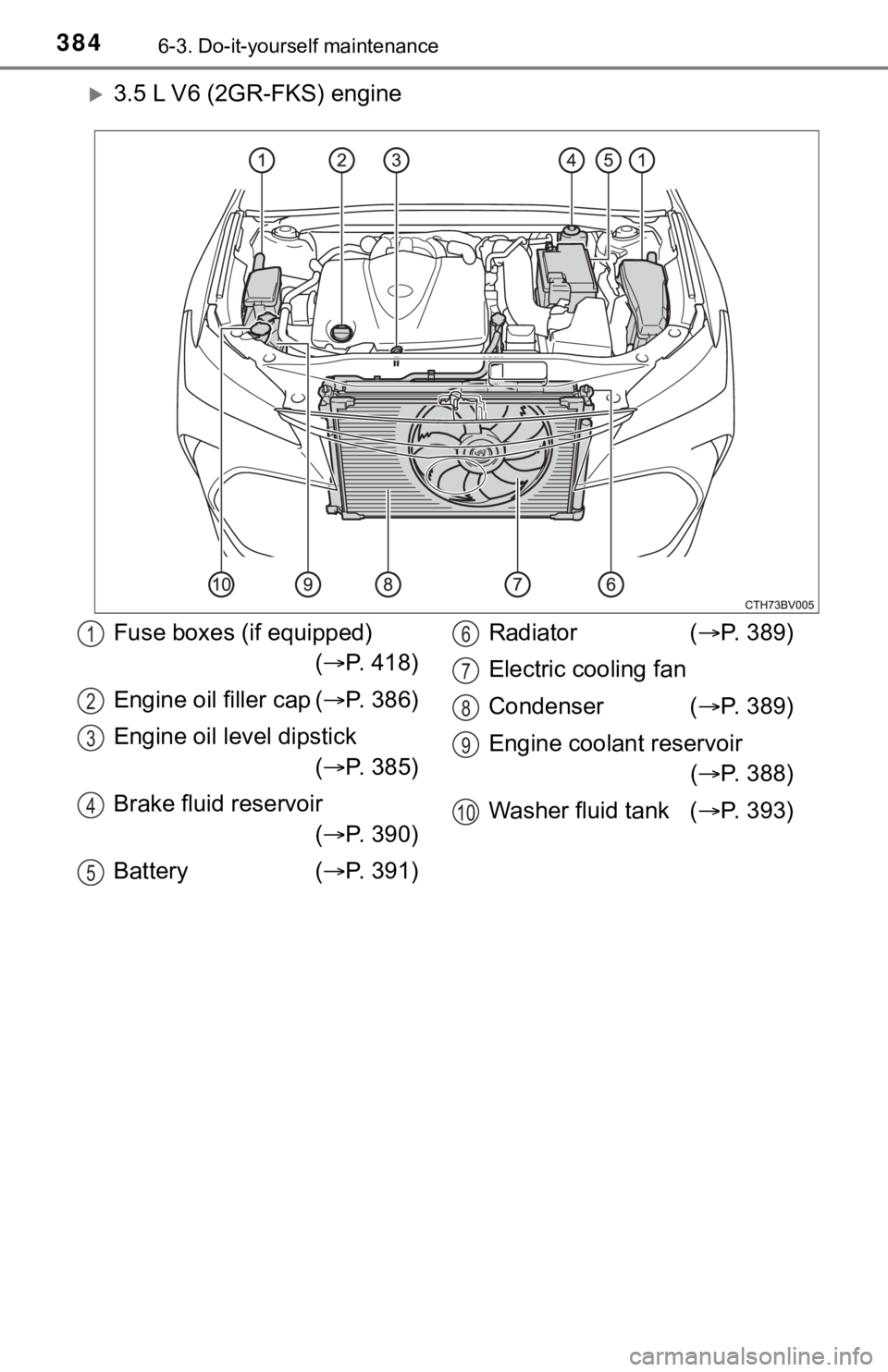
3846-3. Do-it-yourself maintenance
3.5 L V6 (2GR-FKS) engine
Fuse boxes (if equipped)
(P. 418)
Engine oil filler cap (P. 386)
Engine oil level dipstick
(P. 385)
Brake fluid reservoir
(P. 390)
Battery (P. 391)Radiator (P. 389)
Electric cooling fan
Condenser (P. 389)
Engine coolant reservoir
(P. 388)
Washer fluid tank (P. 393)1
2
3
4
5
6
7
8
9
10
Page 388 of 548
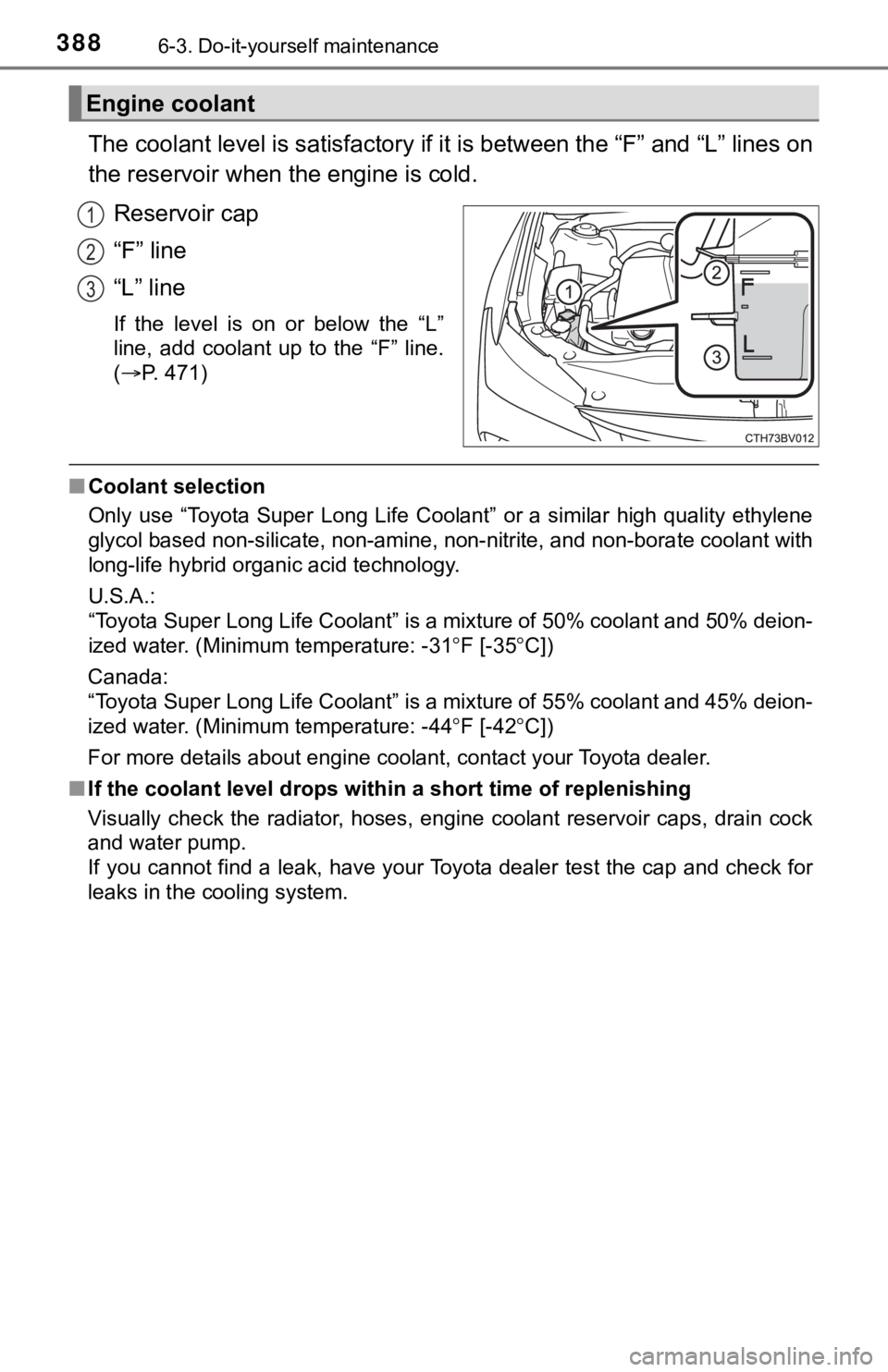
3886-3. Do-it-yourself maintenance
The coolant level is satisfactory if it is between the “F” and “L” lines on
the reservoir when the engine is cold.
Reservoir cap
“F” line
“L” line
If the level is on or below the “L”
line, add coolant up to the “F” line.
(P. 471)
■Coolant selection
Only use “Toyota Super Long Life Coolant” or a similar high quality ethylene
glycol based non-silicate, non-amine, non-nitrite, and non-borate coolant with
long-life hybrid organic acid technology.
U.S.A.:
“Toyota Super Long Life Coolant” is a mixture of 50% coolant and 50% deion-
ized water. (Minimum temperature: -31F [-35C])
Canada:
“Toyota Super Long Life Coolant” is a mixture of 55% coolant and 45% deion-
ized water. (Minimum temperature: -44F [-42C])
For more details about engine coolant, contact your Toyota dealer.
■If the coolant level drops within a short time of replenishing
Visually check the radiator, hoses, engine coolant reservoir caps, drain cock
and water pump.
If you cannot find a leak, have your Toyota dealer test the cap and check for
leaks in the cooling system.
Engine coolant
1
2
3
Page 389 of 548
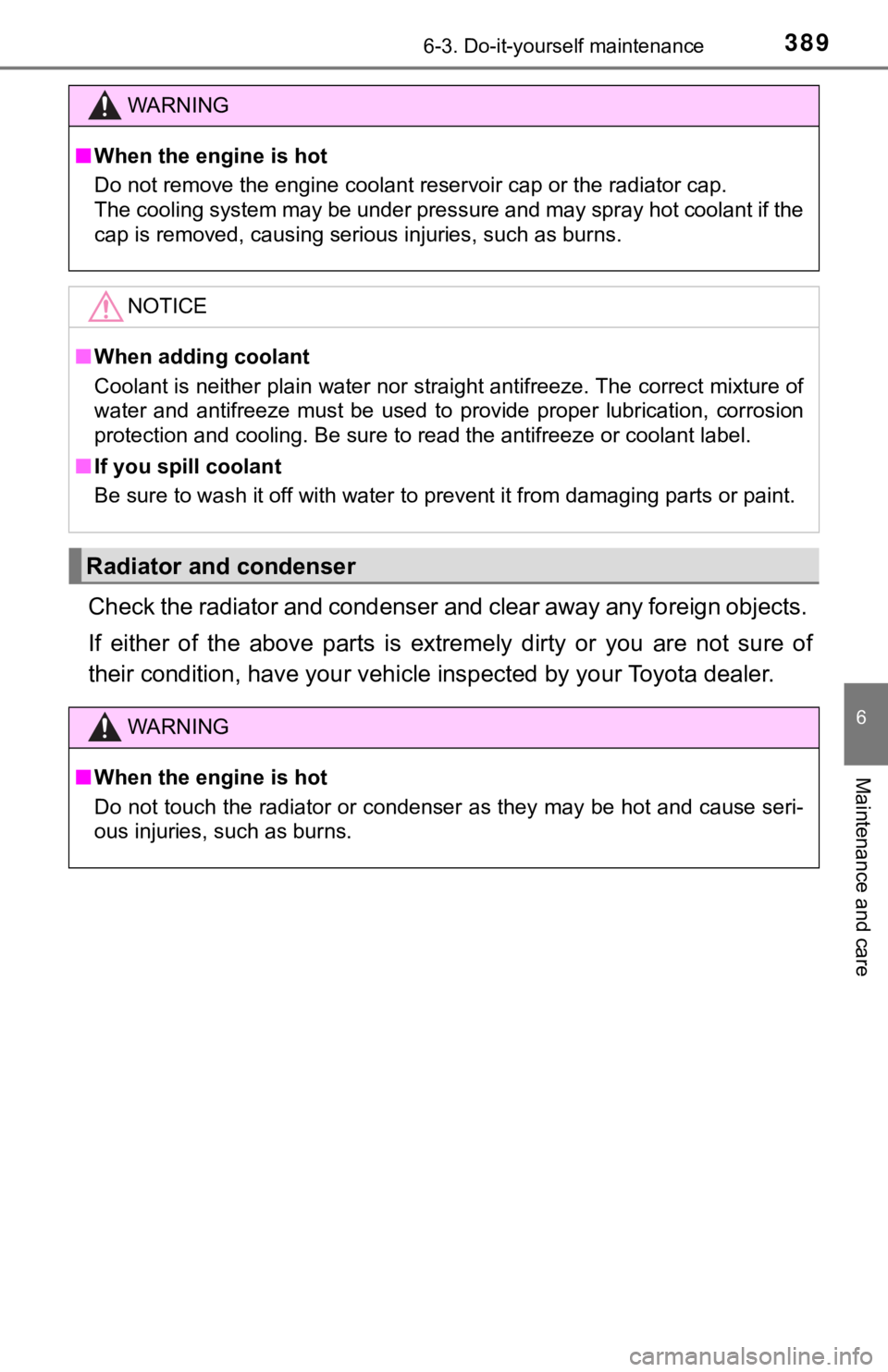
3896-3. Do-it-yourself maintenance
6
Maintenance and care
Check the radiator and condenser and clear away any foreign objects.
If either of the above parts is extremely dirty or you are not sure of
their condition, have your vehicle inspected by your Toyota dealer.
WARNING
■When the engine is hot
Do not remove the engine coolant reservoir cap or the radiator cap.
The cooling system may be under pressure and may spray hot coolant if the
cap is removed, causing serious injuries, such as burns.
NOTICE
■When adding coolant
Coolant is neither plain water nor straight antifreeze. The correct mixture of
water and antifreeze must be used to provide proper lubrication, corrosion
protection and cooling. Be sure to read the antifreeze or coolant label.
■If you spill coolant
Be sure to wash it off with water to prevent it from damaging parts or paint.
Radiator and condenser
WARNING
■When the engine is hot
Do not touch the radiator or condenser as they may be hot and cause seri-
ous injuries, such as burns.
Page 471 of 548
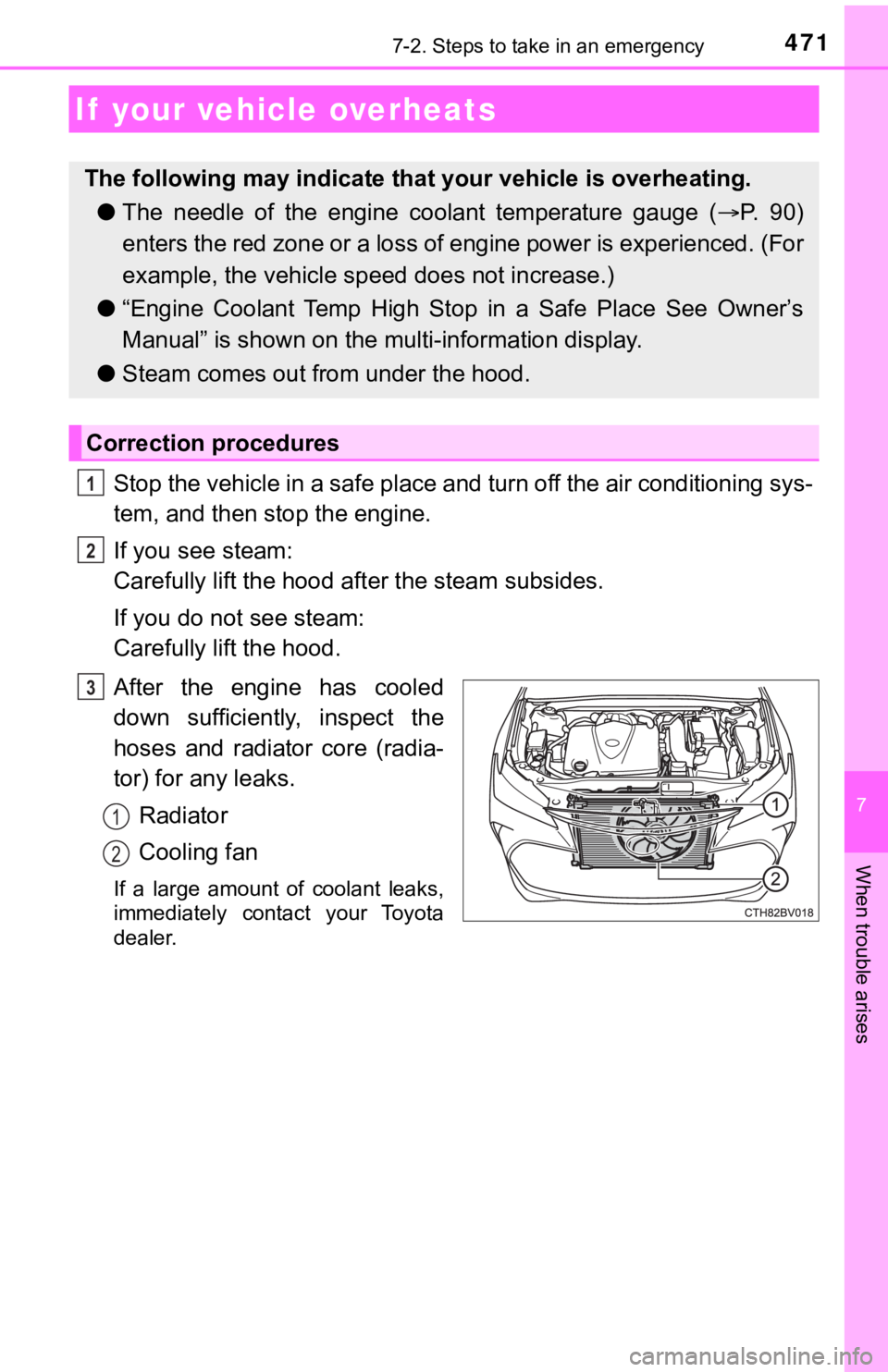
4717-2. Steps to take in an emergency
7
When trouble arises
Stop the vehicle in a safe place and turn off the air conditioning sys-
tem, and then stop the engine.
If you see steam:
Carefully lift the hood after the steam subsides.
If you do not see steam:
Carefully lift the hood.
After the engine has cooled
down sufficiently, inspect the
hoses and radiator core (radia-
tor) for any leaks.
Radiator
Cooling fan
If a large amount of coolant leaks,
immediately contact your Toyota
dealer.
If your vehicle overheats
The following may indicate that your vehicle is overheating.
●The needle of the engine coolant temperature gauge (P. 90)
enters the red zone or a loss of engine power is experienced. (For
example, the vehicle speed does not increase.)
●“Engine Coolant Temp High Stop in a Safe Place See Owner’s
Manual” is shown on the multi-information display.
●Steam comes out from under the hood.
Correction procedures
1
2
3
1
2
Page 472 of 548
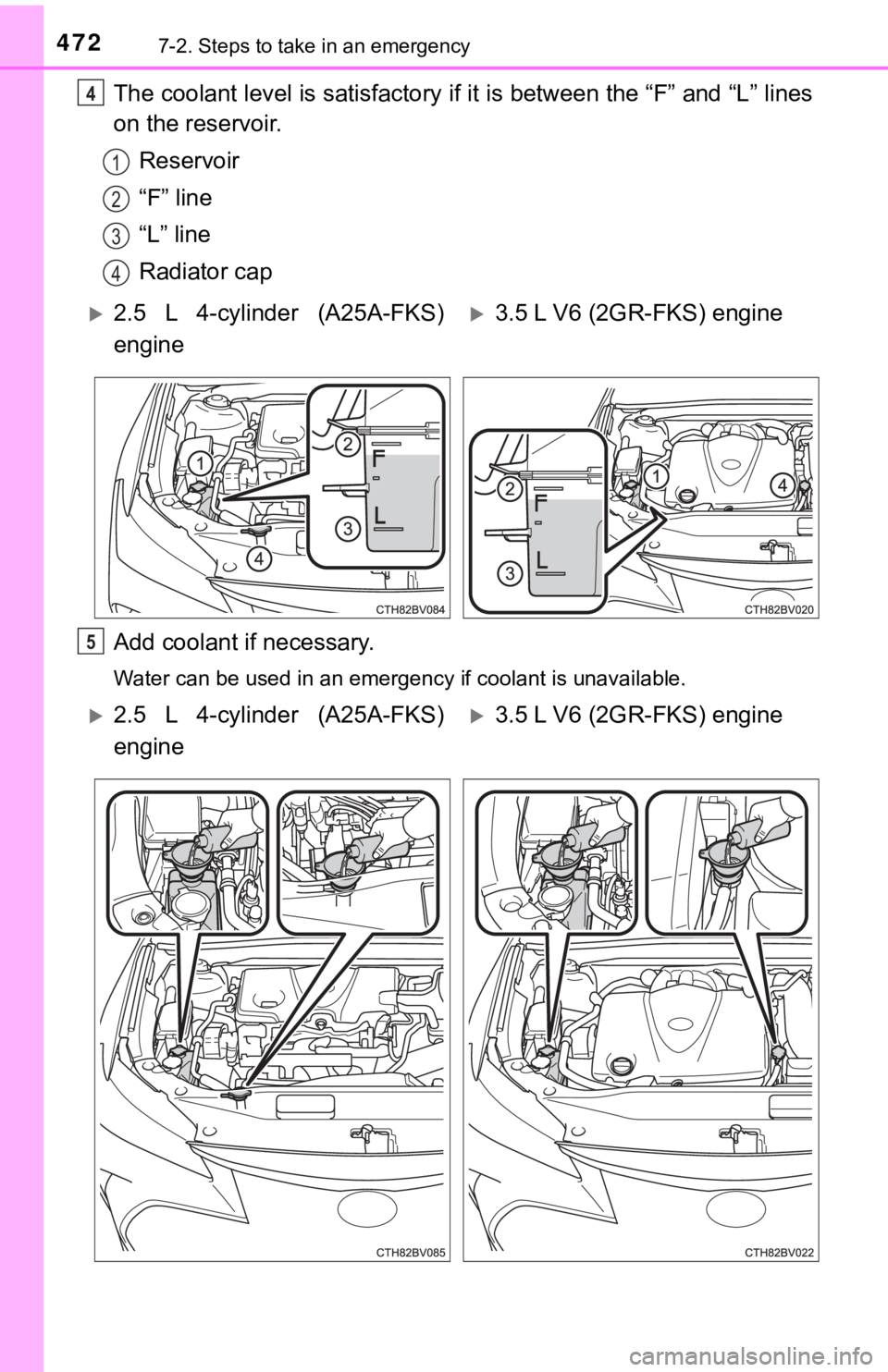
4727-2. Steps to take in an emergency
The coolant level is satisfactory if it is between the “F” and “L” lines
on the reservoir.
Reservoir
“F” line
“L” line
Radiator cap
Add coolant if necessary.
Water can be used in an emergency if coolant is unavailable.
4
1
2
3
4
2.5 L 4-cylinder (A25A-FKS)
engine3.5 L V6 (2GR-FKS) engine
5
2.5 L 4-cylinder (A25A-FKS)
engine3.5 L V6 (2GR-FKS) engine
Page 473 of 548
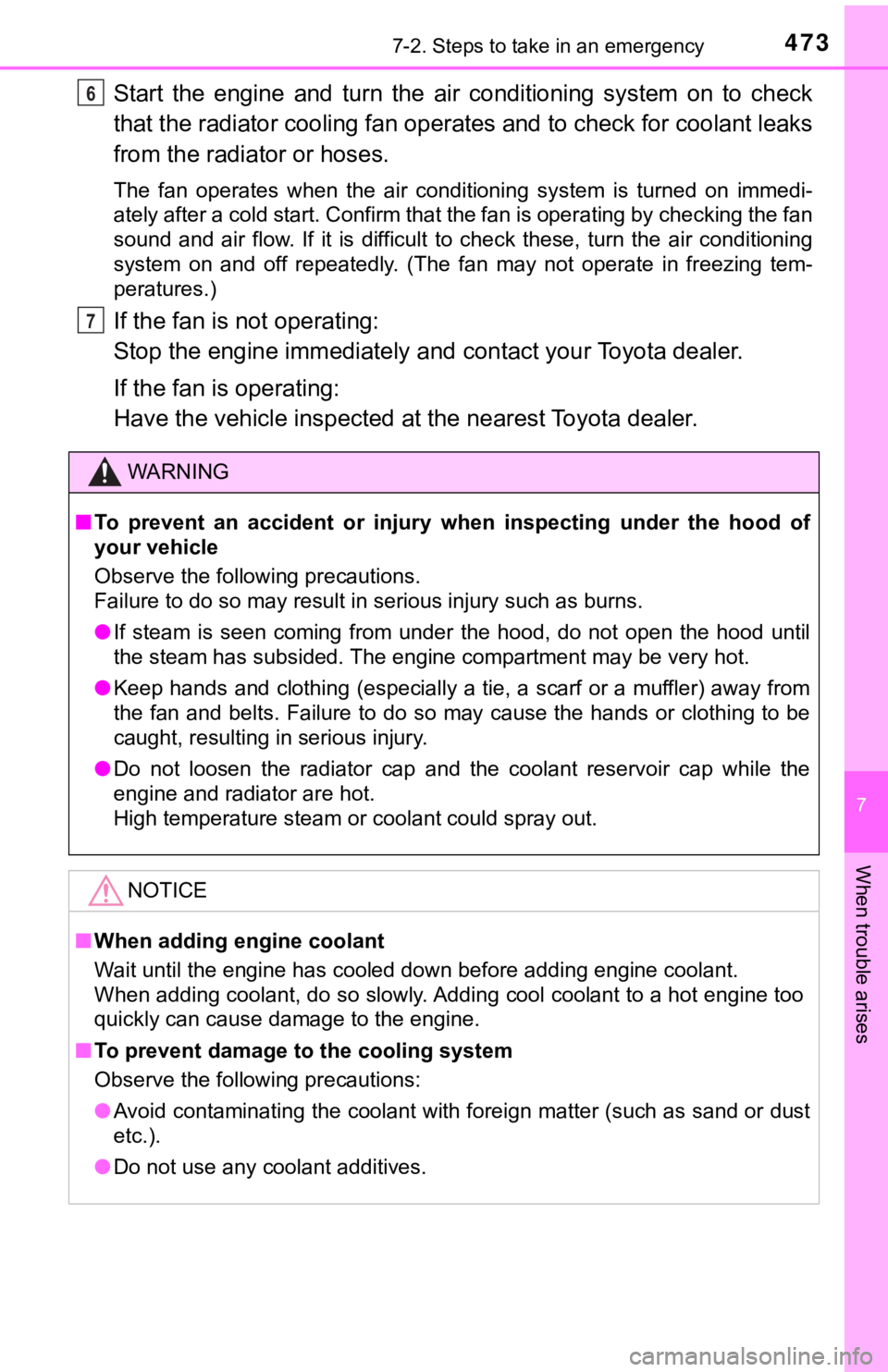
4737-2. Steps to take in an emergency
7
When trouble arises
Start the engine and turn the air conditioning system on to check
that the radiator cooling fan operates and to check for coolant leaks
from the radiator or hoses.
The fan operates when the air conditioning system is turned on immedi-
ately after a cold start. Confirm that the fan is operating by checking the fan
sound and air flow. If it is difficult to check these, turn the air conditioning
system on and off repeatedly. (The fan may not operate in freezing tem-
peratures.)
If the fan is not operating:
Stop the engine immediately and contact your Toyota dealer.
If the fan is operating:
Have the vehicle inspected at the nearest Toyota dealer.
WARNING
■To prevent an accident or injury when inspecting under the hood of
your vehicle
Observe the following precautions.
<00290044004c004f005800550048000300570052000300470052000300560052000300500044005c00030055004800560058004f00570003004c00510003005600480055004c0052005800560003004c0051004d00580055005c0003005600580046004b00
03004400560003004500580055005100560011[
●If steam is seen coming from under the hood, do not open the hood until
the steam has subsided. The engine compartment may be very hot.
●Keep hands and clothing (especially a tie, a scarf or a muffler) away from
the fan and belts. Failure to do so may cause the hands or clothing to be
caught, resulting in serious injury.
●Do not loosen the radiator cap and the coolant reservoir cap while the
engine and radiator are hot.
High temperature steam or coolant could spray out.
NOTICE
■When adding engine coolant
Wait until the engine has cooled down before adding engine coolant.
When adding coolant, do so slowly. Adding cool coolant to a hot engine too
quickly can cause damage to the engine.
■To prevent damage to the cooling system
Observe the following precautions:
●Avoid contaminating the coolant with foreign matter (such as sand or dust
etc.).
●Do not use any coolant additives.
6
7